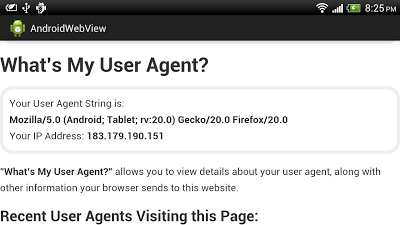package com.example.androidwebview;
import android.os.Bundle;
import android.app.Activity;
import android.webkit.WebView;
import android.webkit.WebViewClient;
public class MainActivity extends Activity {
WebView myWebView;
//final static String myAddr = "http://android-er.blogspot.com";
//final static String myAddr = "http://developer.android.com/";
final static String myAddr = "http://whatsmyuseragent.com/";
//Chrome run on Linux Desktop
//String ua = "Mozilla/5.0 (X11; Linux i686) AppleWebKit/537.31 (KHTML, like Gecko) Chrome/26.0.1410.63 Safari/537.31";
//Chrome run on Android 4.1.1 HTC One X
//String ua = "Mozilla/5.0 (Linux; Android 4.1.1; HTC One X Build/JRO03C) AppleWebKit/537.31 (KHTML, like Gecko) Chrome/26.0.1410.58 Mobile Safari/537.31";
//Firefox run on Android 3.2.1 HTC Flyer 7" Tablet
String ua = "Mozilla/5.0 (Android; Tablet; rv:20.0) Gecko/20.0 Firefox/20.0";
@Override
protected void onCreate(Bundle savedInstanceState) {
super.onCreate(savedInstanceState);
//setContentView(R.layout.activity_main);
myWebView = new WebView(this);
myWebView.getSettings().setUserAgentString(ua);
myWebView.getSettings().setUseWideViewPort(true);
myWebView.getSettings().setLoadWithOverviewMode(true);
myWebView.getSettings().setJavaScriptEnabled(true);
myWebView.setWebViewClient(new MyWebViewClient());
myWebView.loadUrl(myAddr);
setContentView(myWebView);
}
private class MyWebViewClient extends WebViewClient {
@Override
public boolean shouldOverrideUrlLoading(WebView view, String url) {
view.loadUrl(url);
return true;
}
}
}
remark: to check what user-agent your browser set, browse to http://whatsmyuseragent.com/, allows you to view details about your user agent.

No comments:
Post a Comment